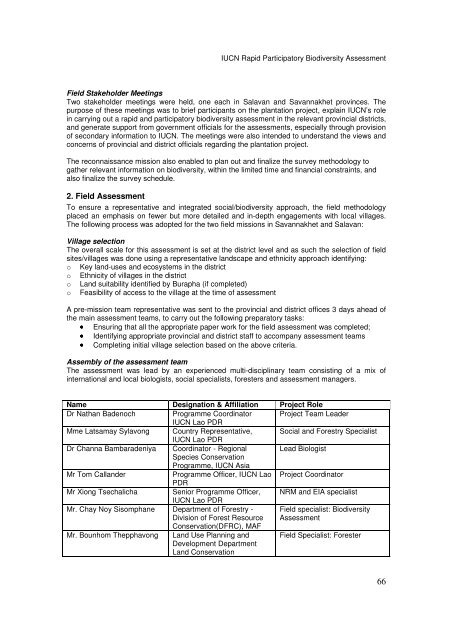Part 1 – A Rapid Participatory Biodiversity Assessment - IUCN
Part 1 – A Rapid Participatory Biodiversity Assessment - IUCN
Part 1 – A Rapid Participatory Biodiversity Assessment - IUCN
You also want an ePaper? Increase the reach of your titles
YUMPU automatically turns print PDFs into web optimized ePapers that Google loves.
<strong>IUCN</strong> <strong>Rapid</strong> <strong>Part</strong>icipatory <strong>Biodiversity</strong> <strong>Assessment</strong><br />
Field Stakeholder Meetings<br />
Two stakeholder meetings were held, one each in Salavan and Savannakhet provinces. The<br />
purpose of these meetings was to brief participants on the plantation project, explain <strong>IUCN</strong>’s role<br />
in carrying out a rapid and participatory biodiversity assessment in the relevant provincial districts,<br />
and generate support from government officials for the assessments, especially through provision<br />
of secondary information to <strong>IUCN</strong>. The meetings were also intended to understand the views and<br />
concerns of provincial and district officials regarding the plantation project.<br />
The reconnaissance mission also enabled to plan out and finalize the survey methodology to<br />
gather relevant information on biodiversity, within the limited time and financial constraints, and<br />
also finalize the survey schedule.<br />
2. Field <strong>Assessment</strong><br />
To ensure a representative and integrated social/biodiversity approach, the field methodology<br />
placed an emphasis on fewer but more detailed and in-depth engagements with local villages.<br />
The following process was adopted for the two field missions in Savannakhet and Salavan:<br />
Village selection<br />
The overall scale for this assessment is set at the district level and as such the selection of field<br />
sites/villages was done using a representative landscape and ethnicity approach identifying:<br />
o Key land-uses and ecosystems in the district<br />
o Ethnicity of villages in the district<br />
o Land suitability identified by Burapha (if completed)<br />
o Feasibility of access to the village at the time of assessment<br />
A pre-mission team representative was sent to the provincial and district offices 3 days ahead of<br />
the main assessment teams, to carry out the following preparatory tasks:<br />
• Ensuring that all the appropriate paper work for the field assessment was completed;<br />
• Identifying appropriate provincial and district staff to accompany assessment teams<br />
• Completing initial village selection based on the above criteria.<br />
Assembly of the assessment team<br />
The assessment was lead by an experienced multi-disciplinary team consisting of a mix of<br />
international and local biologists, social specialists, foresters and assessment managers.<br />
Name Designation & Affiliation Project Role<br />
Dr Nathan Badenoch Programme Coordinator<br />
<strong>IUCN</strong> Lao PDR<br />
Project Team Leader<br />
Mme Latsamay Sylavong Country Representative,<br />
<strong>IUCN</strong> Lao PDR<br />
Social and Forestry Specialist<br />
Dr Channa Bambaradeniya Coordinator - Regional<br />
Species Conservation<br />
Programme, <strong>IUCN</strong> Asia<br />
Lead Biologist<br />
Mr Tom Callander<br />
Programme Officer, <strong>IUCN</strong> Lao<br />
PDR<br />
Project Coordinator<br />
Mr Xiong Tsechalicha Senior Programme Officer,<br />
<strong>IUCN</strong> Lao PDR<br />
NRM and EIA specialist<br />
Mr. Chay Noy Sisomphane Department of Forestry - Field specialist: <strong>Biodiversity</strong><br />
Division of Forest Resource<br />
Conservation(DFRC), MAF<br />
<strong>Assessment</strong><br />
Mr. Bounhom Thepphavong Land Use Planning and<br />
Development Department<br />
Land Conservation<br />
Field Specialist: Forester<br />
66

















